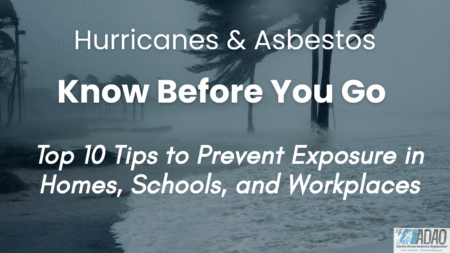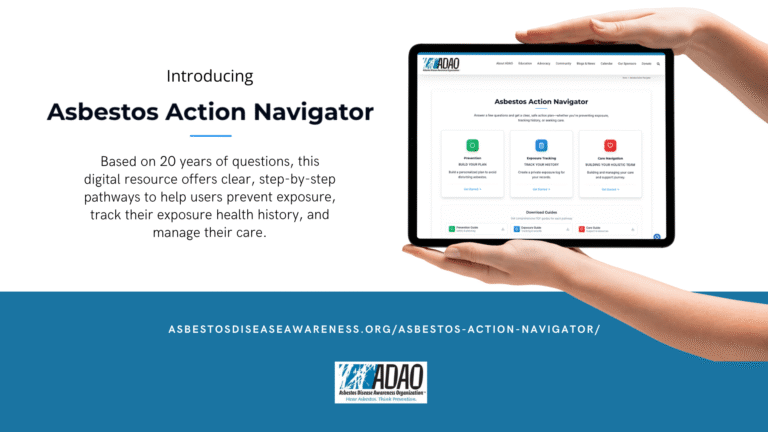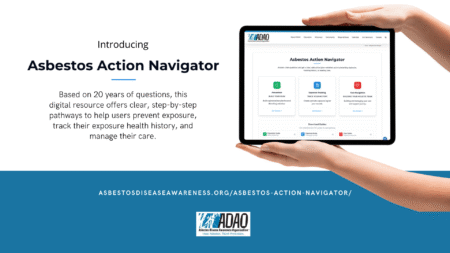Posted on May 26, 2025
Hurricanes & Asbestos: Top 10 Tips to Prevent Exposure in Homes, Schools, and Workplaces
As the 2025 hurricane season begins, communities across the United States once again face the dual threats of natural disasters and toxic exposures. From hurricanes and floods to wildfires and earthquakes, natural disasters can unleash invisible dangers that linger long after the rain stops, the smoke clears, or the floodwaters recede.
Among the most serious and often overlooked public health threats is legacy asbestos.
A Hidden Hazard in Our Homes
Asbestos, a known human carcinogen, was used for decades in building materials such as insulation, vinyl floor tiles, roofing shingles, and cement products. Despite its deadly health risks, asbestos has never been fully banned in the United States. Today, asbestos remains in millions of homes, schools, and public buildings, especially those constructed before the 1980s, referred to as legacy asbestos.
When disasters strike and structures are damaged or destroyed, asbestos-containing materials (ACMs) can break apart, releasing microscopic fibers into the air. These fibers, invisible to the naked eye, can be unknowingly inhaled by first responders, cleanup crews, and returning residents. There is no safe level of exposure because even brief contact can lead to fatal diseases such as mesothelioma, lung cancer, and asbestosis. With no cure for these illnesses, our only protection is prevention: we must take serious, proactive measures to avoid exposure in the first place.

For the past twenty years, ADAO has consistently emphasized the importance of prevention, as illustrated in the 2024 graphic we shared following a series of natural disasters.
The recent fires in Los Angeles, California, and Lahaina, Maui, have offered sobering data about the danger of asbestos following a natural disaster. Testing revealed that more than 30% of the homes in the Palisades and over 50% in Altadena were contaminated with asbestos after the fires. ADAO raised similar concerns about legacy asbestos after the Maui, Hawaii fires, where the destruction of older structures was extensive, compounding the trauma of loss with long-term health risks.
These fires exposed a tragic truth: asbestos is not a problem of the past. It’s a present and urgent risk, especially during disaster recovery.
Hurricanes Compound the Threat
Hurricanes, particularly those striking older, storm-prone regions like Florida, the Carolinas, and the Gulf Coast, can cause extensive structural damage. Broken siding, crumbling drywall, and soaked insulation are more than cleanup tasks; they can be sources of airborne asbestos.
The Environmental Protection Agency (EPA) has issued guidance on managing asbestos after disasters, but awareness remains low, and response coordination often falls short.
The Power of Prevention
ADAO urges public officials, emergency responders, and residents to adopt an asbestos prevention mindset: “Hear Asbestos. Think Prevention.”
10 Key Safety Measures to Prevent Asbestos Exposure After Disasters
- Engage a licensed asbestos professional if you suspect contamination.
- Avoid entering damaged older buildings—disturbance can release fibers.
- Wear N95 masks and proper protective clothing when in disaster zones.
- Do not sweep or vacuum fire or storm debris—this can send asbestos fibers airborne.
- Always dampen debris before handling to prevent dust.
- Avoid disturbing suspicious materials—leave them intact and call an expert.
- Dispose of debris properly using sealed, leak-proof containers.
- Isolate contaminated areas using signage or physical barriers.
- Hire licensed abatement contractors for repairs or demolition.
- Educate your community—awareness saves lives.
A Call to Prevent Exposure, Not Just Respond to It
As climate change intensifies natural disasters, the risk of toxic exposures will only grow. We measure the cost of inaction in innocent lives lost and those harmed by preventable lifelong illnesses.
ADAO remains committed to raising awareness, advancing prevention policies, and protecting communities through education and action. Our deepest gratitude goes to the firefighters, first responders, and emergency teams who put themselves at risk to protect others.
Let’s ensure they, and the families they serve, are protected from the dangers we cannot see.
Stay safe. Stay informed. And remember: prevention is the cure.
For more information, visit: EPA’s Dealing with Debris and Damaged Buildings
Linda Reinstein
President & Co-Founder
Asbestos Disease Awareness Organization (ADAO)
www.asbestosdiseaseawareness.org
linda.reinstein@me.com



